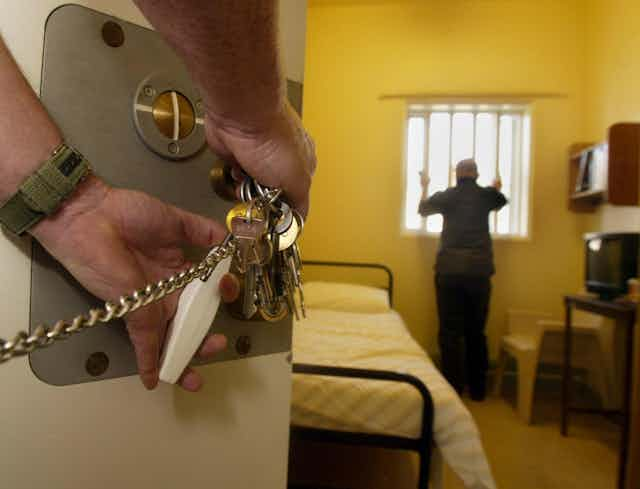The coronavirus pandemic presents one of most pressing public health challenges in a generation. The UK government approach is to limit the number of people who have the virus at any one time and protect the most vulnerable by decreasing the rate of transmission through hand washing and social distancing. But what happens when it is just about impossible to socially distance and you’re in a highly vulnerable group?
Prison environments can create a perfect storm for spreading disease. Inmates often live in unsanitary, overcrowded conditions with limited access to healthcare. In all countries, it is people from the poorest and most marginalised sections of the population who make up the bulk of those serving prison sentences. And many of them have diseases such as tuberculosis, sexually transmitted infections and HIV/AIDS.
Incidence of these diseases in prisons is much higher than in the general population. And older prisoners over 60 are the fastest growing group in prisons. This is particularly concerning since death rates from the coronavirus disease (COVID-19) are highest in this group.
At the time of writing, the first case of COVID-19 in a British prisoner has been confirmed at Strangeways prison in Manchester. A member of prison staff has also tested positive for COVID-19 in another prison. Other staff and prisoners have been placed in isolation as a precaution.
‘Hard to keep clean’
Clearly concerns of a wider outbreak of COVID-19 in prisons are valid, particularly given that prisoners enter custodial settings with a range of complex health needs. But prisons also expose them to further risks. Our research in a prison for young people shows the herculean task placed on prisoners to maintain their physical and mental health in overcrowded, unhygienic and confining conditions.
Even prior to the pandemic, young men in prison told us about the difficulties they faced in maintaining their personal hygiene and accessing appropriate materials and equipment to keep themselves and their environment clean. They said there was a lack of accessible health information. And much of what existed was in written format, despite many prisoner experiencing difficulties with literacy. Overall, 72% of prisoners in our wider prison survey reported difficulties gaining access to information and services to help them maintain good health while in prison.
Our participants also spoke about the long periods of time locked away in their cell – sometimes shared with other prisoners – with some locked away for up to 22 hours a day. Our research found that this boredom often leads to stress and anger, as well as heightened health fears relating to contracting illnesses and the fear of dying alone in a prison cell.
We also found that access to emotional support was severely limited with restricted times available to contact friends and family. With heightened mistrust among prisoners, for many there was no one to turn to about concerns. While some might expect this of prison conditions, such social disconnection could, during a pandemic, increase stress and anxiety in ways that significantly damage prisoners’ health.
Protecting prisoners
Much of the difficulties seem to be down to broader structural constraints placed on prisoners. By the nature of their imprisonment, prisoners cannot plan or make decisions for themselves yet remain at most risk of infections and poorer health.
The Howard League for Penal Reform, a leading UK prison charity, has written to the Ministry of Justice demanding precautions are taken to protect people in prison –- and thereby the wider population – from COVID-19.
In response, prisons minister Lucy Frazer stated that good practice is being promoted on posters and that handwashing facilitates are available to all prisoners. Frazer also said that guidance has been issued about visits to prisons and that contingency plans are in place to protect staff and prisoners alike.
Urgent action needed
But it’s clear that urgent action is required to support and alleviate the concerns of prisoners and their families. Concerns around COVID-19 are even more stark considering that three Chinese provinces registered more than 500 cases in prisons. In Italy, riots are reported to have occurred in at least two dozen prisons after visits were stopped. In one prison at least 12 inmates died after they broke into a healthcare unit and overdosed on methadone.

We need a comprehensive plan from government and health authorities. This must include the ability to quickly detect and isolate cases and the introduction of improved hand washing facilities, stepped up cleaning regimes and personal hygiene protocols.
There should also be a clear and transparent flow of information to manage heightened anxieties. And particular focus on continued contact with family and friends outside of prison using virtual approaches, increasing credit on phone cards and better access to telephones.
Prisoners must also be encouraged to manage their wellbeing through cell based activities such as workouts, education opportunities and access to entertainment and hobbies. There may also be a case for reducing the prison population, which currently stands at around 84,000.
Releasing low category prisoners would free up capacity in what might be a period of staff shortages and increased cases. Iran has already taken this step to temporarily free about 85,000 prisoners in an effort to combat the spread of COVID-19.
Prisons must not be forgotten during this epidemic. It’s also important to remember that staff come and go from these establishments and that most prisoners will be released at some point and will come back into society. Prisoner health and wellbeing cannot be seen as separate from our own.

